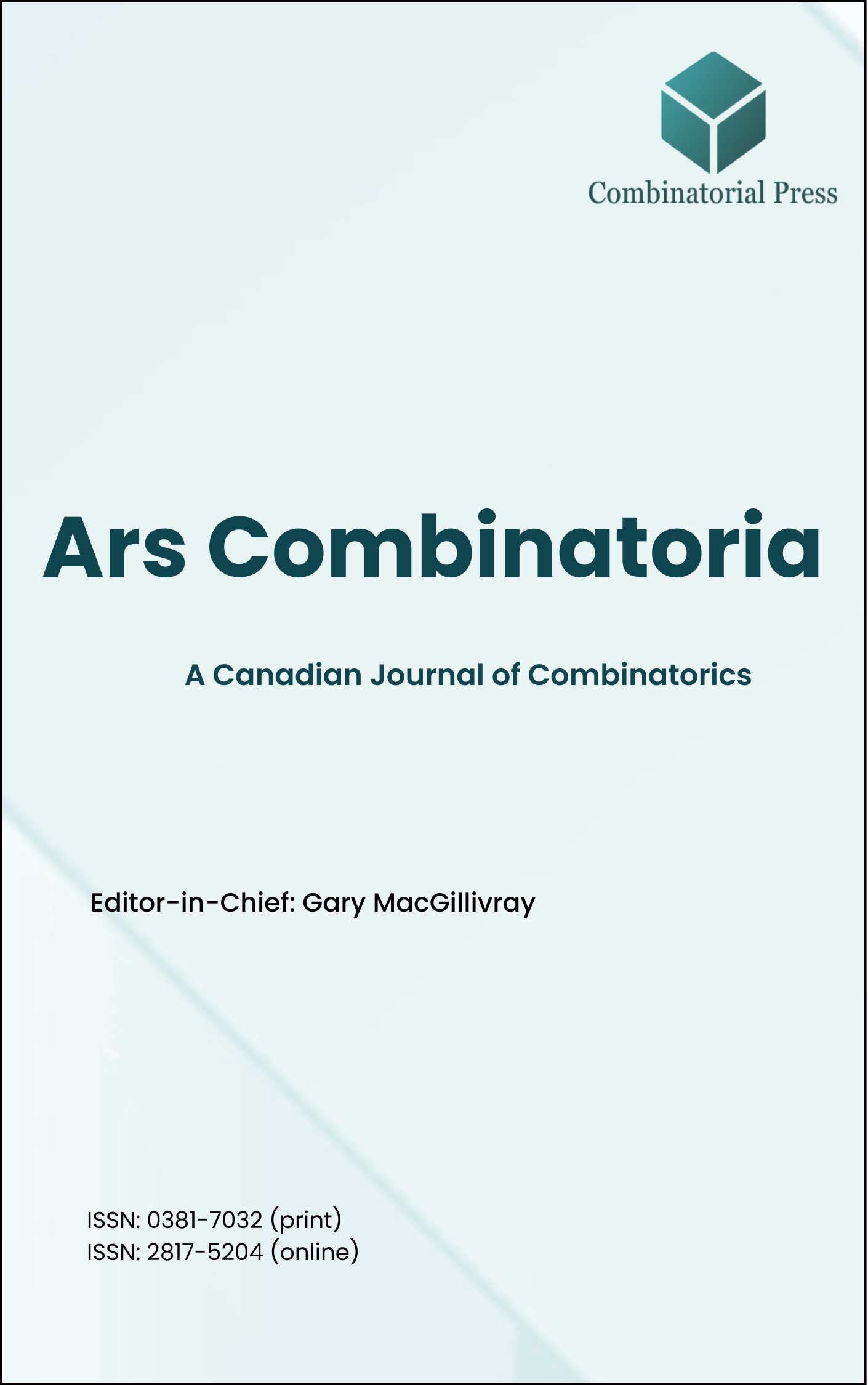
Ars Combinatoria
ISSN 0381-7032 (print), 2817-5204 (online)
Ars Combinatoria is the oldest Canadian Journal of Combinatorics, established in 1976. The journal is dedicated to advancing the field of combinatorial mathematics through the publication of high-quality research papers. From 2024 onward, it publishes four volumes per year in March, June, September and December. Ars Combinatoria has gained recognition and visibility in the academic community and is indexed in renowned databases such as MathSciNet, Zentralblatt, and Scopus. The Scope of the journal includes Graph theory, Design theory, Extremal combinatorics, Enumeration, Algebraic combinatorics, Combinatorial optimization, Ramsey theory, Automorphism groups, Coding theory, Finite geometries, Chemical graph theory but not limited.
Information Menu
- Research article
- Full Text
- Ars Combinatoria
- Volume 043
- Pages: 213-224
- Published: 31/08/1996
The fine structure of a directed triple system of index \(\lambda\) is the vector \((c_1,c_2,\ldots,c_\lambda)\), where \(c_i\) is the number of directed triples appearing precisely \(i\) times in the system. We determine necessary and sufficient conditions for a vector to be the fine structure of a directed triple system of index \(3\) for \(v \equiv 0\) or \(1 \pmod{3}\).
- Research article
- Full Text
- Ars Combinatoria
- Volume 043
- Pages: 203-212
- Published: 31/08/1996
Let \(p\) denote the circumference of a two-connected graph \(G\). We construct a hamiltonian cycle in \(G^2\) which contains more than \(p/2\) edges of \(G\). Using this construction we prove some properties of hamiltonian cycles in the square of \(G\).
- Research article
- Full Text
- Ars Combinatoria
- Volume 043
- Pages: 193-202
- Published: 31/08/1996
For a connected graph \(G\) that is not a cycle, a path or a claw, let its \(k\)-iterated line graph have the diameter \(diam_k\), and the radius \(r_k\). Then \(diam_{k+1} = diam_k + 1\) for sufficiently large \(k\). Moreover, \(\{r_k\}\) also tends to infinity and the sequence \(\{diam_k – r_k – \sqrt{2\log_2 k}\}\) is bounded.
- Research article
- Full Text
- Ars Combinatoria
- Volume 043
- Pages: 191-192
- Published: 31/08/1996
In \([1]\) it is proved that each \(4\)-critical plane graph contains either a \(4\)- or a \(5\)-cycle or otherwise a face of size between \(6\) and \(11\).
- Research article
- Full Text
- Ars Combinatoria
- Volume 043
- Pages: 181-190
- Published: 31/08/1996
For nonempty graphs \(G\) and \(H\), \(H\) is said to be \(G\)-decomposable (written \(G|H\)) if \(E(H)\) can be partitioned into sets \(E_1, \ldots, E_n\) such that the subgraph induced by each \(E_i\) is isomorphic to \(G\). If \(H\) is a graph of minimum size such that \(F|H\) and \(G|H\), then \(H\) is called a least common multiple of \(F\) and \(G\). The size of such a least common multiple is denoted by \(\mathrm{lcm}(F,G)\). We show that if \(F\) and \(G\) are bipartite, then \(\mathrm{lcm}(F,G) \leq |V(F)|\cdot|V(G)|\), where equality holds if \((|V(F)|,|V(G)|) = 1\). We also determine \(\mathrm{lcm}(F,G)\) exactly if \(F\) and \(G\) are cycles or if \(F = P_m, G = K_n\), where \(n\) is odd and \((m-1,\frac{1}{2}(n-1)) = 1\), in the latter case extending a result in [{8}].
- Research article
- Full Text
- Ars Combinatoria
- Volume 043
- Pages: 169-180
- Published: 31/08/1996
Let \(G\) be a graph. A vertex subversion strategy of \(G\), \(S\), is a set of vertices in \(G\) whose closed neighborhood is deleted from \(G\). The survival-subgraph is denoted by \(G/S\). The vertex-neighbor-integrity of \(G\), \(\mathrm{VNI}(G)\), is defined to be \(\mathrm{VNI}(G) = \displaystyle\min_{S\subseteq V(G)} \{|S| + w(G/S)\}\), where \(S\) is any vertex subversion strategy of \(G\), and \(w(G/S)\) is the maximum order of the components of \(G/S\). In this paper, we show the minimum and the maximum vertex-neighbor-integrity among all trees with any fixed order, and also show that for any integer \(l\) between the extreme values there is a tree with the vertex-neighbor-integrity \(l\).
- Research article
- Full Text
- Ars Combinatoria
- Volume 043
- Pages: 159-167
- Published: 31/08/1996
Let \(G\) be a graph of size \(\binom{n+1}{2}\) for some integer \(n \geq 2\). Then \(G\) is said to have an ascending star subgraph decomposition if \(G\) can be decomposed into \(n\) subgraphs \(G_1, G_2, \ldots, G_n\) such that each \(G_i\) is a star of size \(i\) with \(1 \leq i \leq n\). We shall prove in this paper that a star forest with size \(\binom{n+1}{2}\) possesses an ascending star subgraph decomposition under some conditions on the number of components or the size of components.
- Research article
- Full Text
- Ars Combinatoria
- Volume 043
- Pages: 149-157
- Published: 31/08/1996
Let \(G\) and \(H\) be connected graphs and let \(G \square H\) be the Cartesian product of \(G\) by \(H\). A lower and an upper bound for the independence number of the Cartesian product of graphs is proved for the case, where one of the factors is bipartite. Cartesian products with one factor being an odd path or an odd cycle are considered as well.
It is proved in particular that if \(S_1 + S_2\) is a largest 2-independent set of a graph \(G\), such that \(|S_2|\) is as small as possible and if \(|S_2| \leq n+2\), then \(\alpha(G \square P_{2n+1}) = (n+1)|S_1| + n|S_2|\). A similar result is shown for the Cartesian product with an odd cycle. It is finally proved that \(\alpha(C_{2k+1} \square C_{2n+1}) = k(2n+1)\), extending a result of Jha and Slutzki.
- Research article
- Full Text
- Ars Combinatoria
- Volume 043
- Pages: 135-148
- Published: 31/08/1996
Parallel processing has been a valuable tool for improving the performance of many algorithms. Solving intractable problems is an attractive application of parallel processing. Traditionally, exhaustive search techniques have been used to find solutions to \(NP\)-complete problems. However, the performance benefit of parallelization of exhaustive search algorithms can only provide linear speedup, which is typically of little use as problem complexity increases exponentially with problem size. Genetic algorithms can be useful tools to provide satisfactory results to such problems. This paper presents a genetic algorithm that uses parallel processing in a cooperative fashion to determine mappings for the rectilinear crossing problem. Results from this genetic algorithm are presented which contradict a conjecture that has been open for over 20 years regarding the minimal crossing number for rectilinear graphs.
- Research article
- Full Text
- Ars Combinatoria
- Volume 043
- Pages: 121-134
- Published: 31/08/1996
A balanced tournament design, \(\mathrm{BTD}(n)\), defined on a \(2n\)-set \(V\), is an arrangement of the \(\binom{2n}{2}\) distinct unordered pairs of the elements of \(V\) into an \(n \times 2n-1\) array such that:
(1) every element of \(V\) is contained in precisely one cell of each column, and
(2) every element of \(V\) is contained in at most two cells of each row.
If we can partition the columns of a \(\mathrm{BTD}(n)\) defined on \(V\) into three sets \(C_1, C_2, C_3\) of sizes \(1, n-1, n-1\) respectively such that the columns in \(C_1 \cup C_2\) form a Howell design of side \(m\) and order \(2n\), an \(\mathrm{H}(n,2n)\), and the columns in \(C_1 \cup C_3\) form an \(\mathrm{H}(n,2n)\), then the \(\mathrm{BTD}(n)\) is called partitionable. We denote a partitioned balanced tournament design of side \(n\) by \(\mathrm{PBTD}(n)\). The existence of these designs has been determined except for seven possible exceptions. In this note, we describe constructions for four of these designs. This completes the spectrum of \(\mathrm{PBTD}(n)\) for \(n\) even.





